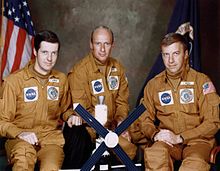
Back Skylab 2 Afrikaans سكايلاب 2 Arabic Скайлаб 2 Bulgarian Skylab 2 Czech Skylab 2 Danish Skylab 2 German Skylab 2 Spanish اسکایلب ۲ Persian Skylab 2 French Skylab 2 Galician
 Skylab, seen from the departing Skylab 2 spacecraft | |
| Operator | NASA |
|---|---|
| COSPAR ID | 1973-032A |
| SATCAT no. | 6655 |
| Mission duration | 28 days, 49 minutes, 49 seconds |
| Distance travelled | 18,500,000 kilometers (10,000,000 nautical miles) |
| Orbits completed | 404 |
| Spacecraft properties | |
| Spacecraft | Apollo CSM-116 |
| Manufacturer | North American Rockwell |
| Launch mass | 19,979 kilograms (44,046 lb) |
| Crew | |
| Crew size | 3 |
| Members | |
| Start of mission | |
| Launch date | May 25, 1973 |
| Rocket | Saturn IB SA-206 |
| Launch site | Kennedy LC-39B |
| End of mission | |
| Recovered by | USS Ticonderoga |
| Landing date | June 22, 1973, 13:49:48 UTC |
| Landing site | 24°45′N 127°2′W / 24.750°N 127.033°W |
| Orbital parameters | |
| Reference system | Geocentric |
| Regime | Low Earth |
| Perigee altitude | 428 kilometers (231 nautical miles) |
| Apogee altitude | 438 kilometers (237 nautical miles) |
| Inclination | 50.0 degrees |
| Period | 93.2 minutes |
| Epoch | June 4, 1973[1] |
| Docking with Skylab | |
| Docking port | Forward |
| Docking date | May 26, 1973, 09:56 UTC |
| Undocking date | May 26, 1973, 10:45 UTC |
| Time docked | 49 minutes[2] |
| Docking with Skylab | |
| Docking port | Forward |
| Docking date | May 26, 1973, 15:50 UTC[2] |
| Undocking date | June 22, 1973, 08:58 UTC[3] |
| Time docked | 26 days, 11 hours, 2 minutes |
 Due to a NASA management error, crewed Skylab mission patches were designed in conflict with the official mission numbering scheme.  L–R: Kerwin, Conrad, and Weitz Skylab program | |
Skylab 2 (also SL-2 and SLM-1[4]) was the first crewed mission to Skylab, the first American orbital space station. The mission was launched on an Apollo command and service module by a Saturn IB rocket on May 25, 1973,[5] and carried NASA astronauts Pete Conrad, Joseph P. Kerwin, Paul J. Weitz to the station. The name Skylab 2 also refers to the vehicle used for that mission. The Skylab 2 mission established a twenty-eight-day record for human spaceflight duration. Furthermore, its crew was the first space station occupants ever to return safely to Earth – the only previous space station occupants, the crew of the 1971 Soyuz 11 mission that had crewed the Salyut 1 station for twenty-four days, died upon reentry due to unexpected cabin depressurization.
The crewed Skylab missions were officially designated Skylab 2, 3, and 4. Miscommunication about the numbering resulted in the mission emblems reading "Skylab I", "Skylab II", and "Skylab 3" respectively.[4][6]
- ^ McDowell, Jonathan. "SATCAT". Jonathan's Space Pages. Retrieved March 23, 2014.
- ^ a b "PART III: Skylab Development and Operations: February 1970-November 1974 (continued)". Skylab: A Chronology. NASA. Retrieved March 26, 2023.
- ^ Gatland, Kenneth (1976). Manned Spacecraft (Second ed.). New York: MacMillan. p. 223. ISBN 0-02-542820-9.
- ^ a b "Skylab Numbering Fiasco". Living in Space. William Pogue Official WebSite. 2007. Archived from the original on February 2, 2009. Retrieved February 7, 2009.
- ^ "Skylab 2 (1973)". Texas Archive of the Moving Image. Retrieved November 29, 2019.
- ^ Pogue, William. "Naming Spacecraft: Confusion Reigns". collectSPACE. Retrieved April 24, 2011.
© MMXXIII Rich X Search. We shall prevail. All rights reserved. Rich X Search